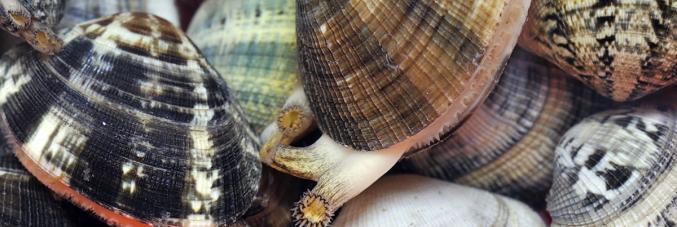
Investigating the impact of dredged sediments on the microbial communities of Manila clams
03.11.2023
The study published in the BMC Biology Journal by the Department of Comparative Biomedicine and Food Science of the University of Padua, in collaboration with Ca' Foscari University of Venice, investigates the potential risk and impact of sediment reuse on organisms inhabiting the Venice lagoon. The study focuses on the Manila clam (Ruditapes philippinarum), a filter-feeding mollusk species of high economic and ecological value for the Venice lagoon.
In the study, Contaminants from dredged sediments alter the transcriptome of Manila clam and induce shifts in microbiota composition researchers exposed clams to sediment samples collected from different sites within one of the Venice lagoon navigable canals close to the industrial area of Porto Marghera, as a means to define the molecular mechanisms behind sediment toxicity. Results reveal transcriptional and microbial changes of Manila clams after exposure to sediments. The work underlines how the correct management in the reuse of dredged sediments is crucial for the conservation of this species and possibly for other organisms inhabiting the Venice lagoon.
Thanks to the scientific activity performed in the Research Programme Venezia2021, coordinated by CORILA, with the contribution of the Provveditorato for the Public Works of Veneto, Trentino Alto Adige and Friuli Venezia Giulia, this study defined the Manila clam molecular mechanisms involved in the response to complex chemical mixtures characteristic of urban and industrial areas.
The management of dredged sediments in ports and lagoons must aim at avoiding potential impacts on marine ecosystems. Therefore, researchers must investigate the possible effects of complex mixtures of chemical contaminants present in sediments on animal species residing in lagoons and coastal areas.
Last author, Tomaso Patarnello explains, “Organisms exposed to polluted sediments, where PCBs concentrations were up to 120 times higher than in control areas, underwent significant alterations in the expression of genes involved in the response to complex chemical mixtures characteristic of urban and industrial areas. In particular, at the transcriptional level, we found a persistent activation of the mTORC1 signalling pathway, which is central in the coordination of cellular responses to chemical stress. We also observed the overrepresentation of potential pathogens and the upregulation of several pathways involved in the immune response of clams exposed to sediments from specific sites.
Corresponding author, Massimo Milan, concludes, “The results obtained highlight how the correct management of dredged sediments is essential for the conservation of this species and, more generally, how investigations conducted at a molecular level can also contribute to understanding the complexity of potential adverse effects on organisms inhabiting the Venice lagoon due to exposure to contaminated sediments.”



